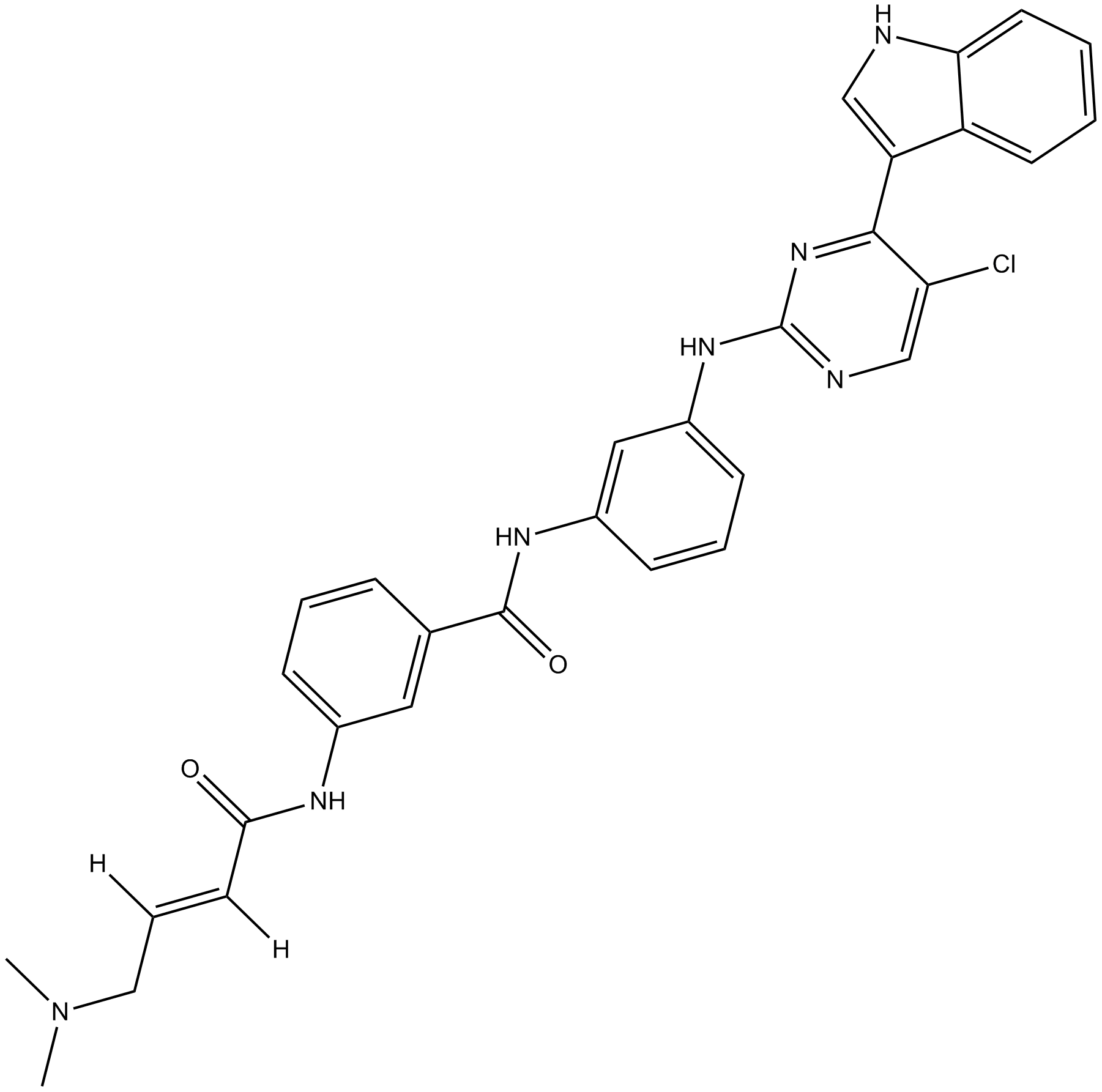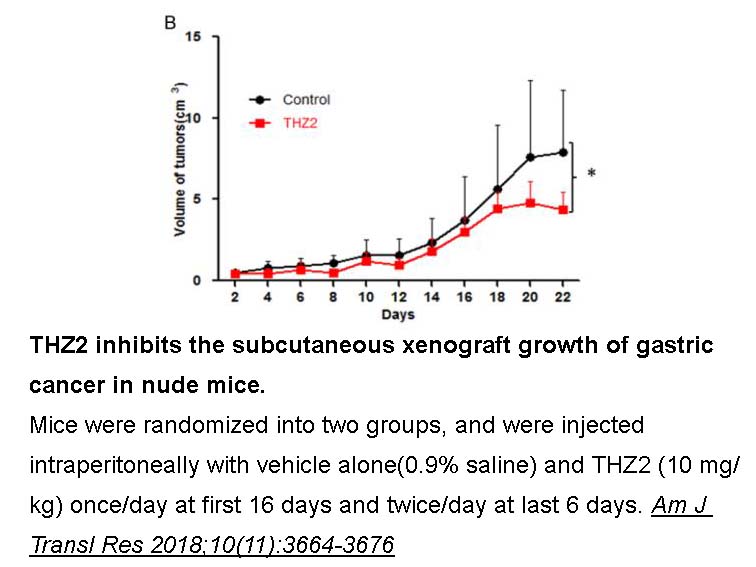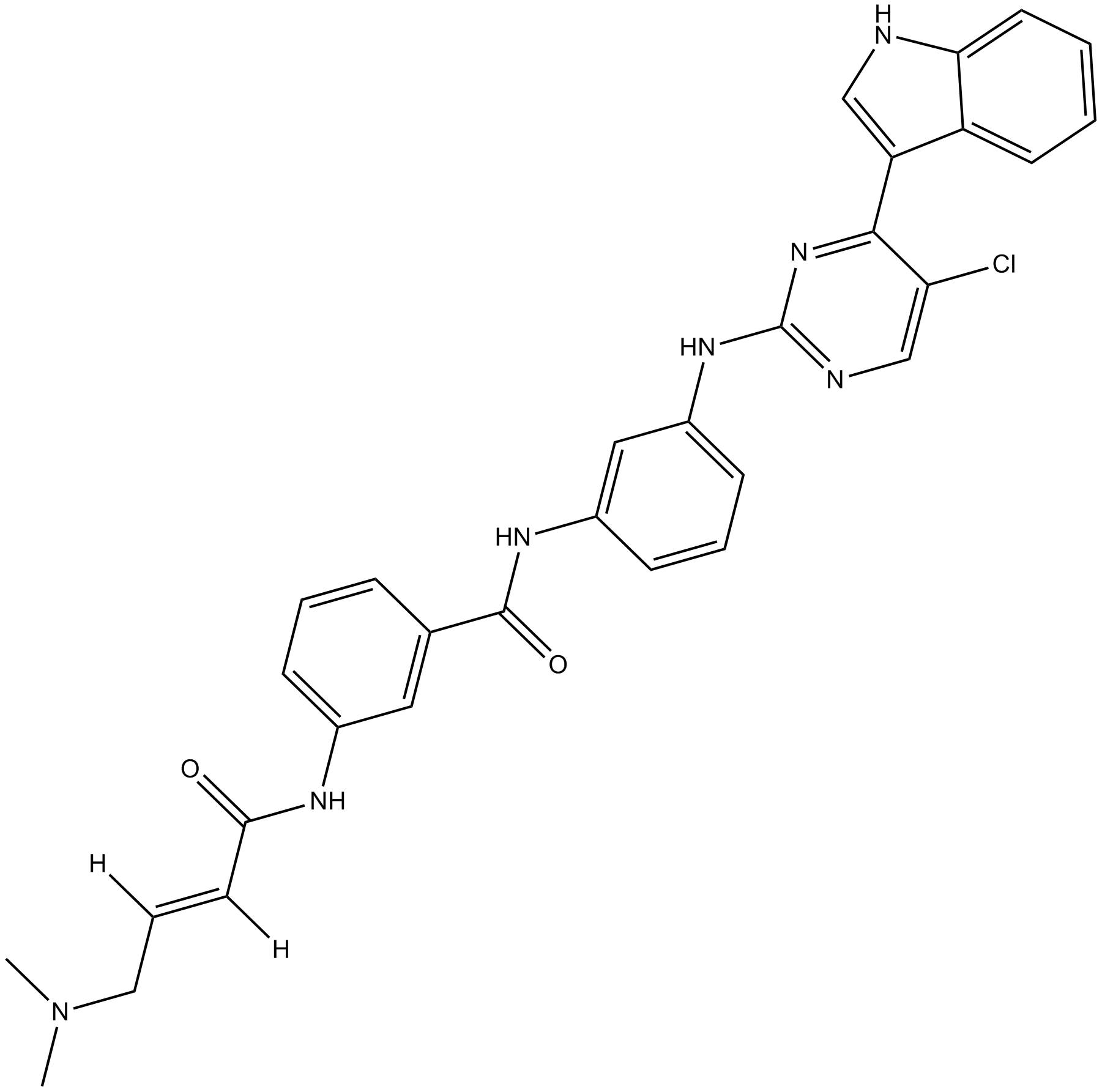THZ2
THZ2 is a potent and selective CDK7 inhibitor (IC50=13.9 nM).
Cyclin-dependent kinase (CDK) is a group of serine/threonine kinases. It is activated by binding to cyclin and participates in the regulation of cell cycle.
THZ2 selectively targets CDK7 and potently blocks the proliferation of triple-negative breast cancer (TNBC) cells and induces apoptotic cell death without causing alteration in cell cycle. The low nanomolar dose of THZ2 also inhibits the clonogenic growth of TNBC cells with IC50 of 10 nM.
THZ2 is well tolerant in mice as 10 mg/kg intraperitoneal treatment of THZ2 twice daily does not cause weight loss or behavioral changes. THZ2 treatment also significantly reduces the tumor growth rate mice. In addition, both acute (50 hr) or chronic (25 days) exposure to THZ markedly decreases CTD phosphorylation of RNAPII at all three phosphorylation sites as indication of CDk7 being efficiently targeted.
Reference:
1. Wang Y, Zhang T, Kwiatkowski N et al. CDK7-dependent transcriptional addiction in triple-negative breast cancer. Cell. 2015 Sep 24;163(1):174-86.
- 1. Sheng-Te Wang, Ying-Ying Wang, et al. "THZ2 Ameliorates Mouse Colitis and Colitis-Associated Colorectal Cancer." Biomedicines. 2024 Mar 18;12(3):679. PMID: 38540292
- 2. Huang JR, Qin WM, et al. "Cyclin-dependent kinase 7 inhibitor THZ2 inhibits the growth of human gastric cancer in vitro and in vivo." Am J Transl Res. 2018 Nov 15;10(11):3664-3676. PMID: 30662617
| Physical Appearance | A solid |
| Storage | Store at -20°C |
| M.Wt | 566.05 |
| Cas No. | 1604810-84-5 |
| Formula | C31H28ClN7O2 |
| Synonyms | CDK7-IN-1 |
| Solubility | ≥28.3 mg/mL in DMSO; insoluble in H2O; ≥2.96 mg/mL in EtOH with gentle warming and ultrasonic |
| Chemical Name | (Z)-N-(3-((5-chloro-4-(1H-indol-3-yl)pyrimidin-2-yl)amino)phenyl)-3-((Z)-((E)-4-(dimethylamino)-1-hydroxybut-2-en-1-ylidene)amino)benzimidic acid |
| SDF | Download SDF |
| Canonical SMILES | CN(C/C([H])=C([H])/C(O)=N/C1=CC=CC(/C(O)=N/C2=CC(NC3=NC=C(Cl)C(C4=CNC5=CC=CC=C45)=N3)=CC=C2)=C1)C |
| Shipping Condition | Small Molecules with Blue Ice, Modified Nucleotides with Dry Ice. |
| General tips | We do not recommend long-term storage for the solution, please use it up soon. |
| Cell experiment [1]: | |
|
Cell lines |
TNBC cells |
|
Preparation method |
The solubility of this compound in DMSO is > 28.3 mg/mL. General tips for obtaining a higher concentration: Please warm the tube at 37 °C for 10 minutes and/or shake it in the ultrasonic bath for a while. Stock solution can be stored below - 20 °C for several months. |
|
Reacting condition |
0.1 ~ 10000 nM; 7 days |
|
Applications |
At low nanomolar doses, THZ2 efficiently suppressed the cell growth of TNBC cells (IC50 = ~ 10 nM). Besides, THZ2 also induced apoptotic cell death in triple-negative, but not ER/PR+, breast cancer cells or normal human cells. Meanwhile, THZ2 did not elicit an obvious alteration in cell cycle. |
| Animal experiment [2]: | |
|
Animal models |
Nude mice bearing triple-negative breast tumors |
|
Dosage form |
10 mg/kg; i.p.; 50 hrs or 25 days |
|
Applications |
In nude mice bearing triple-negative breast tumors, THZ2 significantly reduced the growth rate of tumors without affecting body weight. Moreover, both acute (50 hrs) and chronic exposure (25 days) to THZ2 substantially reduced CTD phosphorylation of RNAPII at all 3 phosphorylation sites (i.e. S2, S5 and S7), which indicated that CDK7 was efficiently inhibited in the tumor cells. According to the immunostaining analysis results of tumor tissues isolated from mice treated with THZ2, reduced proliferation and increased apoptosis were observed. |
|
Other notes |
Please test the solubility of all compounds indoor, and the actual solubility may slightly differ with the theoretical value. This is caused by an experimental system error and it is normal. |
|
References: [1]. Wang Y, Zhang T, Kwiatkowski N et al. CDK7-dependent transcriptional addiction in triple-negative breast cancer. Cell. 2015 Sep 24;163(1):174-86. |
|
Quality Control & MSDS
- View current batch:
Chemical structure

Related Biological Data









